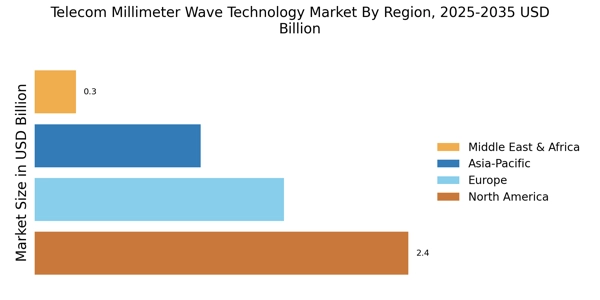Expansion of 5G Networks
The ongoing expansion of 5G networks is a pivotal driver for the Telecom Millimeter Wave Technology Market. As telecommunications companies roll out 5G infrastructure, the integration of millimeter wave technology becomes essential to achieve the high bandwidth and low latency that 5G promises. Reports suggest that by 2025, 5G subscriptions could surpass 1.7 billion, necessitating robust millimeter wave solutions to support the anticipated traffic. This expansion not only enhances mobile broadband services but also facilitates the development of innovative applications such as smart cities, autonomous vehicles, and the Internet of Things (IoT). The convergence of these technologies underscores the critical role of millimeter wave technology in realizing the full potential of 5G, thereby driving market growth.
Government Initiatives and Support
Government initiatives and support play a crucial role in the growth of the Telecom Millimeter Wave Technology Market. Many governments are recognizing the importance of advanced telecommunications infrastructure for economic development and competitiveness. As a result, they are implementing policies and funding programs to encourage the deployment of millimeter wave technology. For example, regulatory bodies are facilitating spectrum allocation for millimeter wave frequencies, which is essential for the successful implementation of 5G networks. Additionally, public-private partnerships are emerging to accelerate the rollout of millimeter wave infrastructure, particularly in underserved areas. These initiatives not only foster innovation but also create a conducive environment for market players to invest in and develop millimeter wave solutions, thereby propelling market growth.
Innovative Use Cases Across Industries
The Telecom Millimeter Wave Technology Market is witnessing innovative use cases across various sectors, which is significantly contributing to its growth. Industries such as healthcare, automotive, and entertainment are increasingly adopting millimeter wave technology to enhance their operational capabilities. For instance, in healthcare, telemedicine applications benefit from high-speed data transmission, enabling real-time consultations and remote monitoring. In the automotive sector, millimeter wave technology supports vehicle-to-everything (V2X) communication, which is crucial for the development of autonomous driving systems. Furthermore, the entertainment industry leverages this technology for high-definition video streaming and virtual reality experiences. These diverse applications not only highlight the versatility of millimeter wave technology but also indicate its potential to transform various industries, thereby driving demand in the market.
Rising Demand for Enhanced Data Speeds
The Telecom Millimeter Wave Technology Market is experiencing a surge in demand for enhanced data speeds, driven by the proliferation of data-intensive applications. As consumers and businesses increasingly rely on high-speed internet for activities such as streaming, gaming, and cloud computing, the need for faster connectivity becomes paramount. According to recent estimates, the demand for data transmission is expected to grow exponentially, with projections indicating that global data traffic could reach 175 zettabytes by 2025. This insatiable appetite for speed is propelling investments in millimeter wave technology, which offers the potential for multi-gigabit per second data rates. Consequently, telecom operators are prioritizing the deployment of millimeter wave infrastructure to meet consumer expectations and remain competitive in a rapidly evolving digital landscape.
Increased Investment in Telecommunications Infrastructure
Increased investment in telecommunications infrastructure is a significant driver for the Telecom Millimeter Wave Technology Market. As the demand for high-speed connectivity escalates, telecom operators are channeling substantial resources into upgrading their networks. This investment is particularly evident in the deployment of millimeter wave technology, which is essential for meeting the growing data demands of consumers and businesses alike. Recent data indicates that global telecom capital expenditures are projected to reach over 300 billion by 2025, with a considerable portion allocated to millimeter wave infrastructure. This influx of capital not only enhances network capabilities but also stimulates competition among service providers, ultimately benefiting consumers through improved services and pricing. The focus on infrastructure investment is likely to sustain the momentum of the millimeter wave technology market in the coming years.


















Leave a Comment